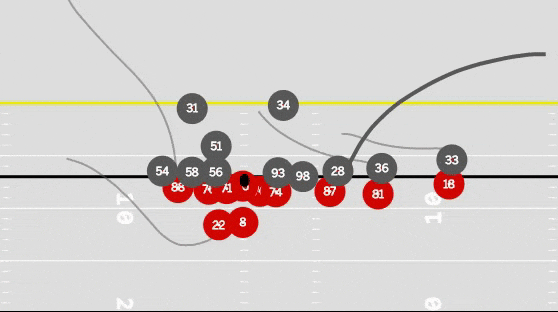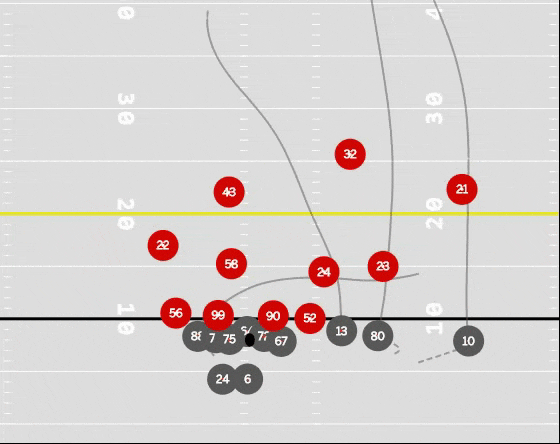I liked everything about Daniel Jones in his debut for the New York Giants, with the strong exception of his new “Danny Dimes” nickname. It’s a moniker better suited for “Leave it to Beaver” or “The Hardy Boys” than a multi-threat quarterback in 2019, and it needs to go away. All suggestions are welcome.
“Danny Dimes” also fails to account for the most fascinating part of Jones’ performance in the Giants’ 32-31 over the Tampa Bay Buccaneers. His pair of rushing touchdowns added 6.2 expected points within the Total QBR formula, the highest total for a quarterback in Week 3 and an incredible departure from decades of Giants history.
And that’s where we’ll start our Week 3 quarterback awards, a weekly distribution of accolades using unique data culled from ESPN Stats & Information and NFL Next Gen Stats. Each Tuesday, we highlight and break down quarterback performances from the NFL weekend. Let’s begin with the rookie out of Duke.

![]()
Make no mistake: Jones had a really impressive passing performance Sunday, one we’ll get to in a moment. But his mobility, specifically his success in finding the end zone on the ground, generated a franchise-altering moment.
The Giants have fielded traditional pocket throwers throughout almost all of the NFL’s passing era, starting with Phil Simms in 1979 and continuing through the likes of Dave Brown, Danny Kanell, Kerry Collins and Eli Manning. There was a brief interlude with Jeff Hostetler from 1990 to ’92, and before Sunday, Hostetler was the only Giants quarterback in 50 years to rush for two touchdowns in a game.
In fact, Hostetler is the only Giants quarterback to appear on the list of the 200 games in which an NFL quarterback has rushed for at least 70 yards in a game since 1970, according to Pro Football Reference’s database. This isn’t to say Jones is the next Michael Vick, but at the very least, his arrival has lifted the Giants into the current quarterback paradigm that all but mandates some ability to move outside of the pocket and pressure defenses.
As a passer, Jones was far more dynamic than we’ve seen from Manning in recent seasons. In the third quarter, he completed a third-down touchdown pass to Sterling Shepard in the corner of the end zone that registered as the sixth-most-unlikely completion of the week (23% completion probability, per NFL Next Gen Stats). Here it is, presented by NFL Next Gen Stats animation:

He completed seven passes that traveled at least 10 yards past the line of scrimmage, for a total of 238 yards. He also completed 7 of 9 passes for 120 yards, including five for first downs, when under pressure. Manning hadn’t thrown for that many yards when pressured in a game since 2014, and he hadn’t converted as many as five first downs in those situations since 2012.
Maintaining that level of passing would ensure a long career for Jones. In the meantime, however, he will give the Giants a level of versatility they haven’t enjoyed in decades — an especially important attribute as the team navigates tailback Saquon Barkley‘s ankle injury.
![]()
Brady completed a number of passes into tight windows, but NFL NextGen Stats pinpointed one in particular for an exceptional level of difficulty. It came on a third-and-22 from the New York Jets‘ 32-yard line with 5:10 remaining in the third quarter.
Brady lofted a pass that traveled 43.4 yards in the air, starting from the moment it left his hand, according to NFL Next Gen Stats. Josh Gordon caught it largely with one hand, 0.3 yards away from the sideline, with the nearest defender 0.9 yards away. NFL Next Gen Stats rated the 28-yard gain as the fourth-most difficult pass to complete in Week 3, with a 15.8% completion probability. What that means to the layperson: Brady’s pass had a high degree of difficulty because of its distance toward the deep pylon, the small window Gordon had because of his proximity to the sideline, and the presence of Jets defender Darryl Roberts running toward Gordon. And yet the two of them made it look easy.
What a catch by @JOSH_GORDONXII! #GoPats #NYJvsNE
📺: CBS
📱: NFL app // Yahoo Sports app
Watch FREE on mobile: https://t.co/qnNxI5gZ8j pic.twitter.com/hkuimqxiF1— NFL (@NFL) September 22, 2019
![]()
Wentz made his share of mistakes in the Eagles’ 27-24 loss to the Detroit Lions, but his pass-catchers let him down in historic fashion. ESPN Stats & Information video analysts docked them for seven drops in his 36 attempts, good for a 19.4% drop percentage.
Wondering whether that is a lot of drops? Why yes, yes it is. Since ESPN began tracking drops in 2006, there have been only three games in which a quarterback had higher drop percentage, with a minimum of 30 attempts. The previous high for an Eagles quarterback since 2006 was 17.8% for Donovan McNabb, who had 45 attempts in a 2006 game against the Giants.
Among Sunday’s drops were two that could have led to scores: Tight end Dallas Goedert was unable to bring in what would have been a 26-yard touchdown reception, and receiver JJ Arcega-Whiteside dropped a pass that would have given the Eagles a fourth-and-goal on their final offensive play.
As a result, Wentz’s completion percentage was 13.2% lower than expected, according to NFL NextGen Stats, the lowest in his career.
![]()
Our Week 2 awards noted — astutely, I might add — that the Saints probably would be able to massage their offense to fit Bridgewater’s strengths while he fills in for injured starter Drew Brees. In his first incarnation as a starter, with the Minnesota Vikings from 2014 to ’15, Bridgewater was exceptionally accurate as a short-range thrower and decidedly unwilling to force the ball downfield.
So what did the Saints do Sunday in Seattle? Coach Sean Payton called an inspired game, limiting Bridgewater to four attempts (among a total of 27) that were 10 or more yards past the line of scrimmage, the fewest among Week 3 starters. Bridgewater averaged 3.3 air yards per pass, the third-lowest by a Saints quarterback since 2006.
None of his 19 completions traveled more than 13 yards, and 80% of his passing yardage — 141 of 177 — came after the catch. That was a higher rate than in any game Brees has started for the Saints.
Whether or not Bridgewater prefers them, short-range throws probably will make sense for the Saints when they play the Dallas Cowboys in Week 4, as well. The Cowboys’ defense has the NFL’s sixth-best QBR (58.9) against throws that travel more than 10 yards in the air. And they rank No. 16 (67.2) on passes that travel 5 or fewer yards downfield.
![]()
Mayfield would have benefited from a Sean Payton game plan Sunday night against the Los Angeles Rams. Facing pressure on 48.7% of his dropbacks, the most of any quarterback in Week 3, Mayfield was far more successful when he could release the ball early.
Make note of that phrasing. I’ll return to it in a moment.
He completed 13 of 18 passes when his throw came less than 2.5 seconds after the snap, and only 5 of 18 when it took longer. It would be easy to say, “Come on, Mayfield, throw it quicker.” But even a cursory view of the Browns’ offense reveals that the schemes and routes did not always give Mayfield a chance to throw before the rush came.
A particularly notable instance came on third-and-10 in the fourth quarter from the Browns’ 10-yard line. Coach Freddie Kitchens’ scheme had three receivers on the right of the formation. All three ran routes deep downfield and were in no position to be targeted when the pass-rush arrived. Mayfield attempted to scramble but was sacked by Clay Matthews on a play that gave the Browns almost no chance to convert a first down. Here it is from NFL Next Gen Stats animation:

Mayfield hasn’t looked as confident this season as he did at the end of 2018. But Kitchens’ scheme didn’t make it easy on him in Week 3. There are ways to adjust when an offensive line is struggling to protect, but the Browns didn’t on Sunday night. It won’t be any easier for them when they travel in Week 4 to play the Baltimore Ravens, whose defense has the NFL’s fourth-best pressure rate at 35.6% this season.
![]()
The highlights will show Rudolph’s strike to receiver JuJu Smith-Schuster, the one that resulted in a 76-yard, catch-and-run touchdown in the Steelers’ 24-20 loss to the San Francisco 49ers. But for the most part, Rudolph presided over a historically un-explosive passing game in his first NFL start.
Rudolph, in fact, completed only two passes that traveled more than 2 yards past the line of scrimmage. Yes, you read that sentence accurately. Since ESPN Stats & Information began tracking games in 2006, there has been only one other occasion when a quarterback — with a minimum of 25 attempts — had completed so few passes beyond the 2-yard mark (Mark Brunell, 2009, in 29 attempts).
It wasn’t as if the Steelers used a particularly conservative game plan. Nearly half of Rudolph’s attempts (13 of 27) traveled 3 or more yards past the line of scrimmage. He just wasn’t successful in completing them. Needless to say, the Steelers will have an awfully difficult time scoring points in the post-Ben Roethlisberger era if their passing game is so limited.
